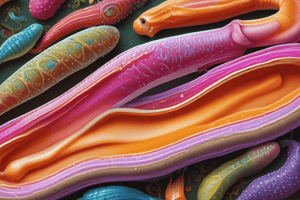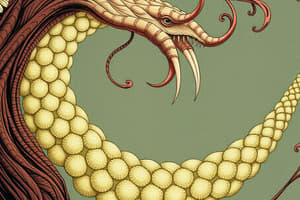Podcast
Questions and Answers
What are the two orders of tapeworms that have medical and public health significance, and how do they differ in terms of their scolex morphology?
What are the two orders of tapeworms that have medical and public health significance, and how do they differ in terms of their scolex morphology?
The two orders of tapeworms that have medical and public health significance are Pseudophyllidea and Cyclophyllidea. Pseudophyllidean tapeworms have a spatulate scolex while Cyclophyllidean tapeworms have a globular scolex.
How do Pseudophyllidean and Cyclophyllidean segments differ in terms of releasing eggs?
How do Pseudophyllidean and Cyclophyllidean segments differ in terms of releasing eggs?
Pseudophyllidean segments release eggs from the gravid uterus, while Cyclophyllidean segments undergo apolysis to release eggs.
What are the intermediate hosts and encysted larvae types of Taenia saginata, Taenia solium, Taenia asiatica, Hymenolepis nana, Hymenolepis diminuta, Dipylidium caninum, Raillietina garrisoni, and Echinococcus granulosus?
What are the intermediate hosts and encysted larvae types of Taenia saginata, Taenia solium, Taenia asiatica, Hymenolepis nana, Hymenolepis diminuta, Dipylidium caninum, Raillietina garrisoni, and Echinococcus granulosus?
Taenia saginata, Taenia solium, and Taenia asiatica have cattle, pigs, and humans as intermediate hosts, respectively, and their encysted larvae are known as cysticerci. Hymenolepis nana and Hymenolepis diminuta have fleas and beetles as intermediate hosts, respectively, and their encysted larvae are known as cysticercoids. Dipylidium caninum has fleas as intermediate hosts and its encysted larvae are known as cysticercoids. Raillietina garrisoni has ants as intermediate hosts and its encysted larvae are known as cysticercoids. Echinococcus granulosus has sheep and other ungulates as intermediate hosts and its encysted larvae are known as hydatid cysts.
Flashcards are hidden until you start studying
Study Notes
- Cestodes are tapeworms grouped into different orders.
- Only two orders have medical and public health significance: Pseudophyllidea and Cyclophyllidea.
- Pseudophyllidean tapeworms have a spatulate scolex while Cyclophyllidean tapeworms have a globular scolex.
- Pseudophyllidean segments have a uterine pore while Cyclophyllidean segments undergo apolysis.
- Diphyllobothrium latum and Spirometra spp. are in the order Pseudophyllidea.
- Taenia saginata, Taenia solium, Taenia asiatica, Hymenolepis nana, Hymenolepis diminuta, Dipylidium caninum, Raillietina garrisoni, and Echinococcus granulosus are in the order Cyclophyllidea.
- The two orders differ in terms of morphology, intermediate hosts, and type of encysted larvae.
- Pseudophyllidean tapeworms have sucking grooves called bothria.
- Cyclophyllidean tapeworms have four muscular suckers.
- Pseudophyllidean segments release eggs from the gravid uterus while Cyclophyllidean segments undergo apolysis to release eggs.
Studying That Suits You
Use AI to generate personalized quizzes and flashcards to suit your learning preferences.



